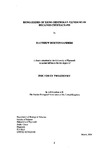BIOMARKERS OF XENO-OESTROGEN EXPOSURE IN DECAPOD CRUSTACEANS
| dc.contributor.author | SANDERS, MATTHEW BURTON | |
| dc.contributor.other | Faculty of Science and Engineering | en_US |
| dc.date.accessioned | 2013-11-04T12:52:21Z | |
| dc.date.available | 2013-11-04T12:52:21Z | |
| dc.date.issued | 2004 | |
| dc.identifier | NOT AVAILABLE | en_US |
| dc.identifier.uri | http://hdl.handle.net/10026.1/2562 | |
| dc.description.abstract |
Many anthropogenic chemicals, most notably xeno-oestrogens, are known to have the potential to disrupt vertebrate endocrine systems. Induction of the female-specific protein vitellogenin (Vtg) in male fish, for example, is a well-known effect of exposure to xeno-oestrogens and serves as a biomarker of such exposure. There have been few comparable studies of putative biomarkers of endocrine disruption in decapods. The current study aimed to establish if reproduction and development of two decapods, the prawn, Palaemon elegans and the crab, Carcinus maenas, were affected following exposure to known oestrogenic chemicals and whether a biomarker approach, analogous to that for vertebrates, could be adopted. The xeno-oestrogen 4-n-nonylphenol (4-NP) was acutely toxic to P. elegans (48h-LC5o, 34.3-96.1 µg Lˉ¹) and C. maenas larvae (48h-LC50, 116-507.3 µg Lˉ¹ ), with P. elegans among the most sensitive species reported. Other than a small, but significant, increase in the mortality of P. elegans larvae exposed to 4-NP at 2 µg Lˉ¹ , neither 4-NP nor the natural oestrogen, 17β-oestradiol (E2) significantly affected growth, development or survival of P. elegans at environmentally realistic concentrations (<0.2-20 µg Lˉ¹ ). Similar results were obtained with C. maenas larvae, but they must be viewed with caution as survival, including that of the controls, was poor. Vitellin-like proteins were identified in the adults and larval stages of both P. elegans and C. maenas using polyclonal antisera to lipovitellin and apolipovitellin. Vtg was female-specific in both species and expression was restricted to females undergoing vitellogenesis. No induction of Vtg was observed in males, from either species, following laboratory exposure to E2, and 4-NP. Likewise, no Vtg was detected in the haemolymph of male C. maenas which had been collected from sites known to be contaminated with oestrogenic chemicals. The titres of the vitellin-like proteins in P. elegans larvae, determined using an indirect ELISA, were significantly affected, in a concentration-independent manner, following exposure to both E2 and 4- NP. Exposure to 4-NP, at 0.2-20 µg Lˉ¹ , resulted in a 5-18% increase in the levels of vitellin-like proteins. Exposure to E2, at 0.2 and 20 µg Lˉ¹ however, reduced levels by up to 11%. Further development of the ELISA is required to assess comparable effects in C. maenas larvae. Overall, while it remains questionable whether these effects result from endocrine disruption, an oestrogen receptor-mediated effect is unlikely. Increased mortality may have been due to toxic effects and no causal link has been established between the parent/exposure compounds and the induced alterations in protein profiles. This study emphasised the necessity for long term multi-faceted studies to determine the real impacts of pollutants at distinct organisational levels. | en_US |
| dc.description.sponsorship | The Marine Biological Association of the United Kingdom | en_US |
| dc.language.iso | en | en_US |
| dc.publisher | University of Plymouth | en_US |
| dc.title | BIOMARKERS OF XENO-OESTROGEN EXPOSURE IN DECAPOD CRUSTACEANS | en_US |
| dc.type | Thesis | |
| plymouth.version | Full version: final and full version as approved by the examiners at the time of the award of your degree | en_US |
| dc.identifier.doi | http://dx.doi.org/10.24382/3235 |
Files in this item
This item appears in the following Collection(s)
-
01 Research Theses Main Collection
Research Theses Main


